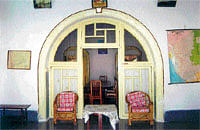
A row of rocky hills. A small town that sits in the middle of these boulders. A 167-year-old bungalow constructed on the peak of one such hill. This bungalow, built to resemble the letter ‘T’ in the English language, has at least one door on every outer wall.
There are four rooms and as many as 27 doors! When every door of the building is closed, and there is a knock on any one of them, all the doors begin to shake. This has been planned for safety, and is based on sound principles of construction and science. The building we are talking about is Taylor’s Manzil.
The bungalow is in today’s Yadgir taluk’s Surapur and was built by British officer Philip Meadows Taylor, who also served as the Resident of Surapur. It was he who created the blueprint for the building.
Who was Taylor?
It was Philip Meadows Taylor (1808-76) who introduced India and its culture to the West, by way of his well-known works such as Confessions of a Thug. The work was popular not only in England, but the whole of Europe.
Taylor also contributed immensely to historical research in India. He first landed in India at the age of fifteen. He came looking for a job, and started work as a clerk in Aurangabad.
Later, he served in the police and military units of the British and rose to the ranks of Captain-Colonel too. Taylor became extremely popular in India thanks to his administrative policies. To people who couldn’t pronounce his name, he became ‘Mahadeva Baba’.
Taylor in Surapur
Surapur brings to mind Venk atappa Nayaka who fought the British in 1857. Nalwadi Venkatappa Nayaka was seven years old when Taylor came to Surapur. Taylor was sent to Surapur as Regent to resolve administrative issues related to the principality. Captain Gresly who had come to Surapur before Taylor left the town, unable to handle resistance from the local regime.
Venkatappa Nayaka’s father Krishnappa Nayaka had died an untimely death, and the throne had fallen vacant. Before Queen Eshwaramma could deliver a male child, Krishnappa Nayak had declared his brother Pidda Nayaka as the crown prince. It was Pidda Nayaka’s desire to crown him the king.
But, Queen Eshwaramma wanted to coronate her own son as the king. It was when there was a lot of confusion and the entire province was split over this that Taylor landed in Surapur. It was not easy for him to take all parties involved into confidence and come to a fair decision. However, Taylor, who conducted himself with immense equanimity, patience and grace, was successful in helping seven-year-old Venkatappa Nayaka ascend the throne. But the anger of the other group now turned towards the young king and Taylor.
Taylor sensed that an attack was being planned against him during the Dasara procession, but was able to thwart it successfully. Taylor had to spend his initial days in Surapur in great anxiety. Meanwhile, he had decided to build his residence in Surapura. He built the bungalow far away from the town, and at a great height, in the year 1844.
The second half of Taylor’s 12-year regime in Surapura was largely peaceful, and there was much progress in the region during his administration. Taylor, who was very close to King Venkatappa Nayaka ensured that the king was not only well versed in weaponry, but also trained in other forms, and was well-educated and knowledgeable.
Nalwadi Venkatappa Nayak was known to address Taylor as ‘appa’ (father) with great love. When Taylor’s administration came to an end, the king could not bear to bid him goodbye.
Because Taylor had begun the construction of the building in an atmosphere of fear and anxiety, safety was on his mind the most. The building was constructed in such a manner that there was an escape route if an attack was launched from any side. He had envisaged the building plan to ensure that he would know when the main door was opened from his own room. When one stands at the entrance of the bungalow, one would realise that there are two doors right next to main door. There is also a separate door that leads to the rooms on the left side.
There is a huge drawing room, a dining room and two other big rooms. The building has been constructed in such a manner that it will stay cool even in summer.
There are many pieces of furniture inside the building which are ‘T’ shaped. A chair and some pieces of china that Taylor is said to have used are now housed in Gulbarga’s Government Museum.
There are signs to show that there was a park in front of the bungalow at one point. The ‘Kudure Gudda’ (a hillock called the ‘Horse peak’) was called Taylor’s peak by localites.
If one sits here, one gets a panoramic view of the whole town, from the line of hills in the distance to a view of the horizon. Taylor’s bungalow is a must-see for anyone visiting Gulbarga district.